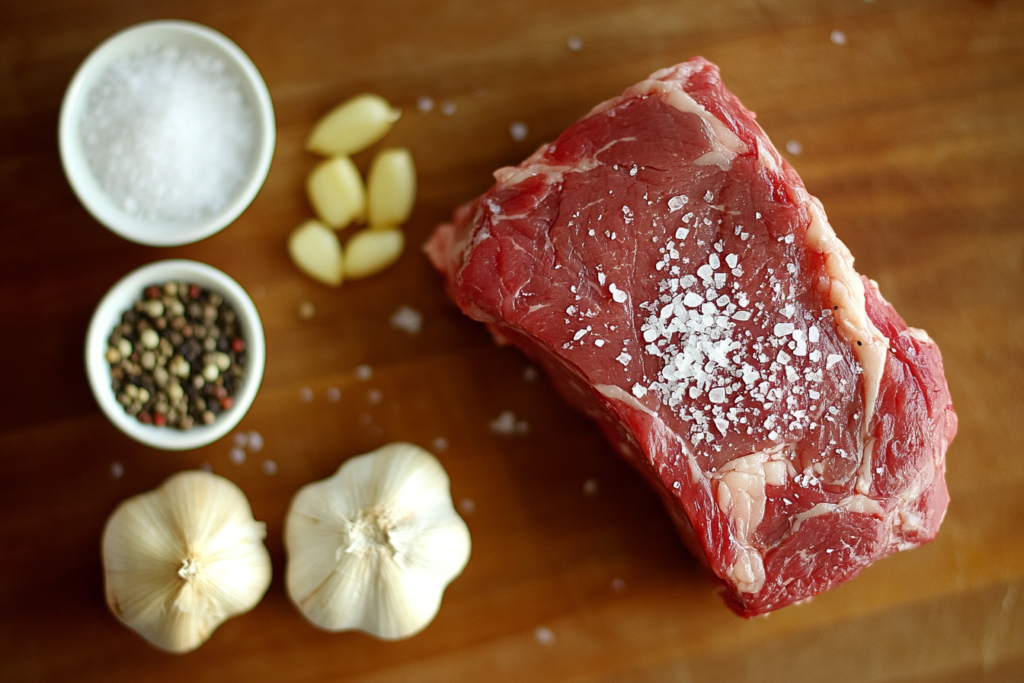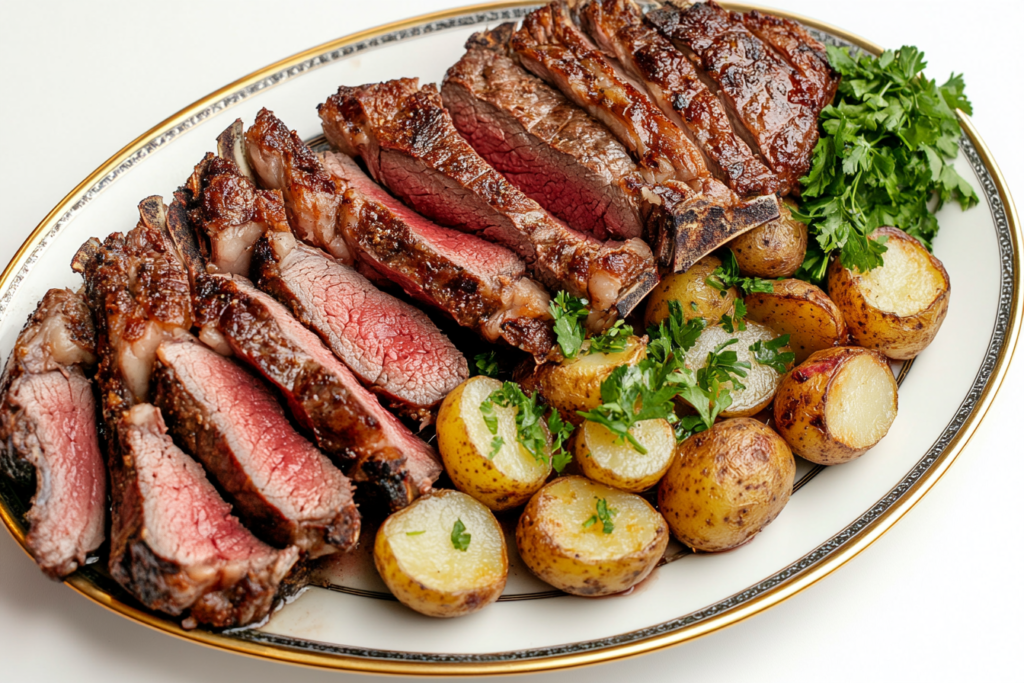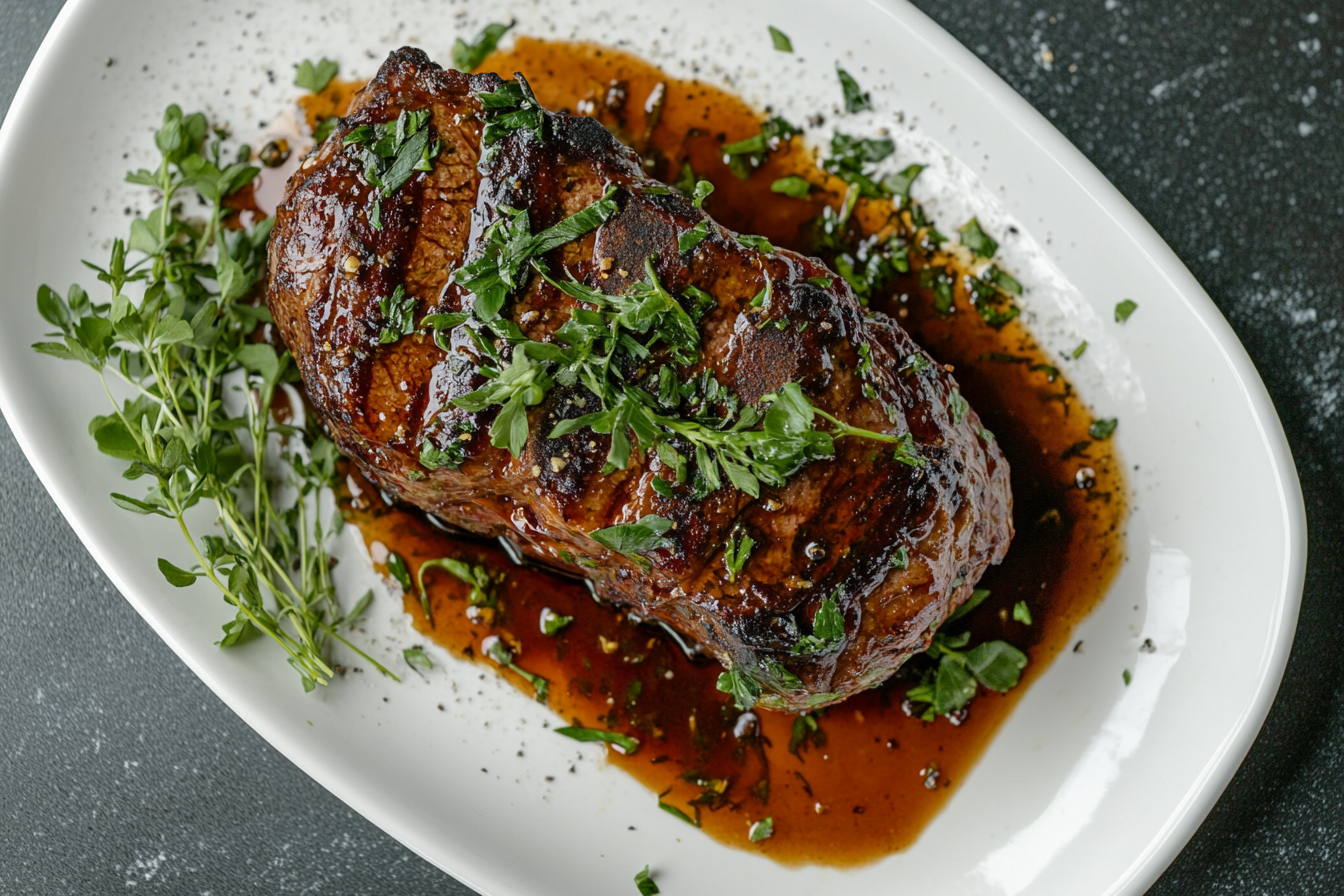Relish a sumptuous ribeye roast that’s succulent, aromatic, and perfect for both cozy gatherings and festive celebrations.
Table of Contents
ToggleIntroduction
A ribeye roast remains one of the most distinguished beef cuts, prized for its tender texture and rich marbling. When prepared correctly, it transforms into a masterpiece that highlights every juicy bite. Because it possesses natural flavor and sweetness, this roast deserves thoughtful selection, careful seasoning, and precise cooking. Indeed, once you learn these fundamentals, you’ll find yourself serving a ribeye roast that wows both family and friends.
Below, delve into everything from choosing the ideal roast to slicing it like a pro. Explore various seasonings, cooking methods, and side dishes that complement the roast’s hearty depth. Ultimately, a ribeye roast stands as a testament to the art of straightforward, satisfying cuisine. With patience and the right technique, you’ll achieve consistent, mouthwatering results.
Ribeye Roast Essentials and Key Traits
A ribeye roast hails from the rib section of the cow, typically including bones from ribs six through twelve if bone-in. This portion holds robust marbling, which accounts for its signature tenderness. Moreover, it carries layers of meaty flavor that many other cuts fail to match. Because these muscle groups remain relatively inactive, each slice of ribeye roast ends up extremely tender.
Ribeye roast also sports a substantial fat cap in some cases, or at least some noticeable external fat. This protective layer often melts during cooking, bathing the roast’s interior in delicious juices. If you buy a bone-in version, you may see it labeled as a standing rib roast. The bones can provide extra flavor, though carving might require more finesse. By contrast, a boneless cut streamlines slicing but may omit that classic presentation.
Through the years, professional chefs and home cooks alike have praised ribeye roast for its bold taste. Because of the marbling, the roast stays moist, even if you push it slightly beyond medium-rare. Still, most experts recommend medium-rare to medium for an optimal balance of internal juiciness and well-browned crust. Overcooking can diminish the roast’s prized texture, so keep a thermometer handy.
Selecting Your Ribeye Roast at the Butcher
When seeking a ribeye roast, pay attention to marbling. White specks of fat interspersed throughout the muscle hint at fuller flavor and improved moisture retention. Indeed, higher marbling usually indicates a more premium grade, like USDA Prime or Choice. In many cases, a Choice-grade roast with even marbling yields sumptuous results without the Prime price tag.
Ask your butcher if they’ll remove excess surface fat or tie the roast for uniformity. This ensures more even cooking. Also, decide whether you want a roast with the deckle (the cap portion) intact. Many find it the most succulent part, so skipping it would mean missing out on a special delicacy. Regardless of your specific request, choosing a ribeye roast with balanced marbling forms the foundation for success.
Because not all grocery stores carry the same grade or cut, you may need to visit a butcher shop or high-end supermarket. Searching for deals can help if your budget is tight. However, it’s essential to remember that the ribeye roast is a premium selection. Splurging occasionally rewards you with a feast that leaves a lasting impression on all who taste it.
Understanding Bone-In vs. Boneless Ribeye Roast
A bone-in ribeye roast retains some or all of the rib bones. Often referred to as a standing rib roast, it can offer extra flavor through the bones. Meanwhile, a boneless roast consists solely of the meat, simplifying carving. Either choice can yield a spectacular meal, so personal preference should drive your decision.
If you pick bone-in, some butchers will “French” the bones for a more elegant look or will partially separate them from the roast, then tie them back on. This convenience allows you to easily remove the bones after cooking, retaining the flavor benefits. Alternatively, a boneless ribeye roast is more straightforward to slice and may require a shorter cooking time. Because both versions maintain the same luscious interior, your selection primarily depends on presentation style.
Ribeye Roast Prepping and Seasoning

Before you even consider cooking your ribeye roast, set it up for success. Basic preparation includes trimming surplus fat if necessary, tying with butcher’s twine for uniform shape, and deciding on seasoning. This step significantly influences the final taste, ensuring the roast emerges beautifully cooked and bursting with savory notes.
Trimming and Tying for Even Cooking
Some ribeye roast cuts arrive with pockets of external fat. Although internal fat (marbling) is beneficial, too much surface fat can inhibit a crisp crust or lead to uneven browning. Gently trim large lumps, leaving a modest layer intact to baste the meat. If the roast is exceptionally large, tying in 2-inch intervals with twine helps maintain a cylindrical shape for consistent heat distribution.
Because a more uniform thickness fosters even cooking, your roast gains a reliable texture from edge to center. Over time, these simple measures prevent scenarios where certain parts finish earlier than others. Some roasts come pre-tied by the butcher, so confirm whether additional tying is needed. Ultimately, a well-prepared ribeye roast stands a better chance of delivering succulent slices with no dryness.
Seasoning Rubs for Ribeye Roast
A minimalistic approach, such as salt and freshly cracked pepper, can suffice for a ribeye roast. The natural marbling ensures robust flavor. However, those seeking more complexity can craft their own rub. For instance, combine chopped rosemary, thyme, garlic powder, and a dash of onion powder. Mix with salt and pepper, then press it onto every surface of the roast.
Another tactic involves using a simple marinade. Let the roast sit in a mixture of olive oil, garlic cloves, and herbs for a few hours. Because extended marinating might soften the roast’s outer layer excessively, keep marinade durations moderate—two to four hours at most. If you prefer a purely authentic taste, rely on salt and pepper. Indeed, ribeye roast stands well on its own, so extra seasoning is optional, not mandatory.
For the best results, season the roast generously at least an hour before cooking or even overnight in the fridge. This dry brine period allows salt to dissolve and permeate, boosting flavor from within. By the time you start cooking, the ribeye roast has a head start on tenderness and taste.
Ribeye Roast Cooking Methods for All Skill Levels
Selecting a cooking technique can feel overwhelming. However, whether you’re a seasoned chef or new to roasts, a ribeye roast adapts to multiple styles. Because of its reliable fat content, it’s forgiving if you watch the timing and temperature. Below are three main methods that each highlight different aspects of the roast’s profile.
Oven-Roasting the Ribeye Roast
The classic and most popular technique is oven-roasting. Preheat your oven to 325°F. Place the ribeye roast on a rack in a roasting pan, ensuring hot air circulates underneath. Slide the pan into the oven and insert a reliable thermometer in the thickest part. Generally, plan about 20 minutes per pound for medium-rare, though the real measure remains internal temperature.
Around 30 minutes before the estimated finish, begin checking the thermometer reading. Because the final doneness matters most, remove it when the center hits about 130–135°F for medium-rare. Afterward, rest the roast under foil, which allows the temperature to climb a bit more. Overcooking a ribeye roast wastes its marbling advantage, so vigilance with the thermometer is essential.
Grilling or Smoking a Ribeye Roast
Outdoor cooking fans might prefer grilling or smoking. For grill-roasting, set half the grill for indirect heat at around 300–325°F. Place the ribeye roast on the cooler side, and let it cook slowly. If smoking, pick a wood that won’t overpower the meat—oak, pecan, or mild fruitwoods often suit. Because the cut is already robust, a mild smoke infuses dimension without overshadowing the roast.
Check internal temperature periodically. Rotate the roast if your grill has hot spots. For a savory crust, finish with a brief sear over direct heat or stoke the coals for a final blast. Then, let it rest off the grill. Because the flavors of char and smoke marry well with the roast’s inherent richness, this method thrills adventurous eaters seeking bold results.
Sous Vide for the Ribeye Roast
A modern method, sous vide cooking, brings temperature control to an art form. Seal the ribeye with your chosen seasoning in a vacuum bag, then immerse it in a water bath set to the desired final temperature (e.g., 130°F for medium-rare). Wait patiently as it cooks evenly from edge to center over several hours. When done, remove from the bag, pat dry, and give it a finishing sear in a hot pan or on a grill.
The advantage lies in guaranteed doneness throughout the ribeye roast. You won’t risk dryness in the outer layers. However, the oven or grill’s roasty aroma might be less pronounced. The final sear reintroduces a crispy exterior, bridging the gap between science and tradition. For fans of perfect uniform pinkness, sous vide stands as a top-tier option.
Ribeye Roast Doneness and Carving Techniques
Determining doneness demands accuracy and caution. Because a ribeye roast can vary in shape, time-based guidelines might mislead. Thus, a good digital thermometer becomes your ally, ensuring the internal temperature precisely meets your preference.
Checking Internal Temperatures for Ribeye Roast
The ideal internal temperature depends on personal taste:
- Rare: 120–125°F
- Medium-Rare: 130–135°F
- Medium: 140–145°F
- Medium-Well: 150–155°F
- Well-Done: 160°F+
Insert the thermometer into the roast’s thickest point, avoiding bone or large fat pockets. Because the edges cook faster than the center, a central reading best indicates overall doneness. Remove the ribeye roast from heat about 5°F below your target, as carryover cooking raises the temp slightly while it rests.
Resting Before Carving
Resting your ribeye roast for at least 15 minutes under loosely tented foil locks in its juices. If carved too soon, the roast might lose valuable moisture onto your cutting board. Because the muscle fibers relax during rest, every slice emerges more tender and flavorful. Large roasts might benefit from a 20-minute rest. Meanwhile, use that window to prepare sauces, set the table, or finalize side dishes.
When ready, place the roast on a sturdy board, hold it steady, and slice across the grain. This ensures the pieces remain tender. Aim for half-inch slices or adjust thickness to your liking. Some folks prefer thicker, steak-like cuts. Ultimately, the final product should display a warm, rosy interior that captures the essence of a perfectly cooked ribeye roast.
Serving and Sides for Ribeye Roast Dinners

A ribeye roast can shine alone, but well-chosen sides elevate the entire meal. Typically, you want accompaniments that contrast or enhance the roast’s richness. Consider creamy or starchy dishes that absorb the roast’s juices. Or pick lighter fare that cuts through the meat’s fatty mouthfeel.
- Mashed or Roasted Potatoes: Classics that soak up gravy or drippings.
- Buttered Vegetables: Carrots, asparagus, or Brussels sprouts for color and nutrition.
- Simple Salads: Crisp greens with tangy vinaigrette for a refreshing palate cleanser.
- Low-Carb Alternatives: Try zucchini pasta or pair slices with avocado toast with feta for a modern spin.
- Soup Starters: A light vegetarian tortilla soup can precede the roast, warming guests up before the main course.
Because ribeye roast is already robust, aim to keep side dishes simple, ensuring the centerpiece remains the star. For sauces, a classic au jus or horseradish cream can complement rather than overpower. Choose minimal yet flavorful sauces that highlight the beef’s natural juiciness.
Wine Pairings for Ribeye Roast
For a ribeye roast, bold red wines typically prove ideal. Cabernet Sauvignon stands as a popular choice, thanks to its tannins balancing the roast’s fat content. Malbec or Merlot also mesh well, offering roundness and fruitiness. If you prefer something lighter, a Pinot Noir might suffice, though it can be overshadowed by the roast’s intensity. Because individual palates differ, experiment to find a personal favorite. Over time, you’ll discover which reds best complement the melt-in-your-mouth goodness.
Troubleshooting Ribeye Roast Cooking Challenges
Even seasoned cooks face obstacles with a ribeye roast. Overcooking, dryness, or uneven doneness can happen. However, these pitfalls needn’t ruin your meal if you approach them calmly and methodically.
Avoiding Overcooked or Dry Results
Patience and a thermometer remain your best protection. Once internal temperatures exceed 145°F (medium), dryness risk escalates, though the roast’s marbling offers some leeway. If you suspect it’s edging past your desired point, remove it from heat promptly. Let it rest a bit longer to distribute juices. If dryness does occur, slice thinner and serve with a sauce or gravy.
Another trick is basting periodically if you’re cooking at moderate oven temps. Additionally, keep your oven calibrated. Sometimes an oven set to 325°F actually runs hotter. Confirm actual temperatures with an oven thermometer to ensure accurate cooking times.
Dealing with Underseasoned Ribeye Roast
If your ribeye roast emerges bland, a robust sauce can salvage each bite. Au jus or a red wine reduction intensifies beefy notes. Alternatively, a flavored butter—like garlic-parsley or rosemary-thyme butter—spreads easily onto each slice, enhancing taste. Next time, remember to salt generously in advance, letting flavors develop. Because seasoning a thick roast demands more salt than typical steaks, be bold with that initial rub.
Frequently Asked Questions
Is ribeye good for roasting?
Absolutely. A ribeye roast is fantastic for roasting because its marbling preserves moisture and flavor. When cooked properly, it yields a tender, melt-in-your-mouth texture. Many consider ribeye among the finest choices for a satisfying roast dinner.
Is a ribeye roast the same as a rib roast?
These terms often overlap. A “rib roast” can be bone-in, while ribeye roast usually refers to a boneless version. However, both come from the same section and share similar taste and tenderness. If you see “standing rib roast,” that typically indicates bones remain attached.
How long does it take to cook a ribeye in the oven?
Times vary by roast size and desired doneness. As a rule of thumb, plan on about 20 minutes per pound at 325°F for a medium-rare ribeye roast. Always rely on a thermometer to confirm internal temperature. Remove it a few degrees early because carryover cooking will raise the heat slightly while resting.
Is ribeye roast tough or tender?
A ribeye roast is known for its tenderness. Its extensive marbling keeps it moist, and proper cooking yields a succulent bite. Overcooking can toughen it, but careful timing and resting ensure softness. Indeed, many fans consider it one of the most tender roasts available.
Conclusion
A ribeye roast captures the essence of luxurious dining. Its remarkable marbling and bold flavor combine to produce a centerpiece that delights guests and elevates any meal. Whether you opt for classic oven-roasting, adventurous grilling, or precision sous vide, each slice can stun with tenderness when you follow best practices. Most important, use a thermometer and give the roast time to rest.
Selecting the highest-quality cut you can afford, seasoning with intention, and pairing it with complementary sides all contribute to success. Over time, your technique refines, turning each ribeye roast cooking experience into a confident, triumphant event. Embrace the versatility of this cut, from minimal salt-and-pepper rubs to elaborate herb crusts or subtle marinade enhancements. Ultimately, a carefully prepared ribeye roast sets the stage for memorable gatherings, whether for intimate family dinners or holiday banquets.

